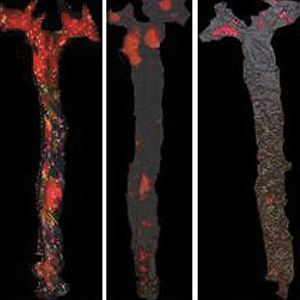Original Articles
Vol. 1 No. 2 (2022)
A nitric oxide-donor pravastatin hybrid drug exerts antiplatelet and antiatherogenic activity in mice

Publisher's note
All claims expressed in this article are solely those of the authors and do not necessarily represent those of their affiliated organizations, or those of the publisher, the editors and the reviewers. Any product that may be evaluated in this article or claim that may be made by its manufacturer is not guaranteed or endorsed by the publisher.
All claims expressed in this article are solely those of the authors and do not necessarily represent those of their affiliated organizations, or those of the publisher, the editors and the reviewers. Any product that may be evaluated in this article or claim that may be made by its manufacturer is not guaranteed or endorsed by the publisher.
Received: 9 February 2022
Accepted: 6 May 2022
Accepted: 6 May 2022
4765
Views
313
Downloads
Similar Articles
- Maria J. Fernandez Turizo, Rushad Patell, Jeffrey I. Zwicker, Identifying novel biomarkers using proteomics to predict cancer-associated thrombosis , Bleeding, Thrombosis and Vascular Biology: Vol. 3 No. s1 (2024)
- PO35 | Cerebral veins thrombosis in patients with and without myeloproliferative neoplasm: a real life retrospective monocentric study , Bleeding, Thrombosis and Vascular Biology: Vol. 4 No. s1 (2025)
- CO04 | Direct oral anticoagulants in antiphospholipid syndrome: a single center real-life experience , Bleeding, Thrombosis and Vascular Biology: Vol. 4 No. s1 (2025)
- Francesco Marongiu, Elvira Grandone, Silvia Marongiu, Antonella Mameli, Doris Barcellona, Stroke in women: anticoagulation in a complicated puzzle , Bleeding, Thrombosis and Vascular Biology: Vol. 3 No. 2 (2024)
- PO80 | Heparin-induced thrombocytopenia: a monocentric experience with danaparoid , Bleeding, Thrombosis and Vascular Biology: Vol. 4 No. s1 (2025)
- Francesca Santilli, Paola Simeone, Rossella Liani, Inflammation, platelets and diabetes , Bleeding, Thrombosis and Vascular Biology: Vol. 2 No. 2 (2023)
- PO38 | Rates of hemorrhagic events and hemodialysis circuit thrombosis in patients with end-stage renal disease on hemodialytic treatment receiving a factor-XI inhibitor: a systematic review and meta-analysis , Bleeding, Thrombosis and Vascular Biology: Vol. 4 No. s1 (2025)
- PO81 | Direct oral anticoagulants in atypical site vein thrombosis: a single centre experience focused on cancer patients , Bleeding, Thrombosis and Vascular Biology: Vol. 4 No. s1 (2025)
- Niccolò Bitto, Vincenzo La Mura, Anna Ludovica Fracanzani, Armando Tripodi, Is non-alcoholic fatty liver disease a prothrombotic risk factor? , Bleeding, Thrombosis and Vascular Biology: Vol. 2 No. 2 (2023)
- Gualtiero Palareti, Paolo Prandoni, Cristina Legnani, Emilia Antonucci, Serena Zorzi, Alberto Tosetto, Lorenza Bertù, Sophie Testa, Vittorio Pengo, Walter Ageno, Ida Martinelli, Benilde Cosmi, Eugenio Bucherini, Daniela Poli, Rationale and design of a study on D-dimer use to stratify patients after a first unprovoked venous thromboembolism for their risk of recurrence: extended low-dose Apixaban given only to patients with positive D-dimer results , Bleeding, Thrombosis and Vascular Biology: Vol. 1 No. 1 (2022)
You may also start an advanced similarity search for this article.
Most read articles by the same author(s)
- Daniela Poli, Emilia Antonucci, Gualtiero Palareti, Roberto Facchinetti, Pietro Falco, Giuseppina Serricchio, Teresa Lerede, Lucilla Masciocco, Paolo Gresele, Sophie Testa, Major bleedings in mechanical prosthetic heart valves patients on Vitamin K antagonist treatment. Data from the PLECTRUM Study , Bleeding, Thrombosis and Vascular Biology: Vol. 1 No. 2 (2022)
- Paolo Gresele, Artificial intelligence and machine learning in hemostasis and thrombosis , Bleeding, Thrombosis and Vascular Biology: Vol. 2 No. 4 (2023)
- Loredana Bury, Paolo Gresele, The amazing genetic complexity of anucleated platelets , Bleeding, Thrombosis and Vascular Biology: Vol. 1 No. 2 (2022)
- Paolo Gresele, Synthetic platelets: can bioengineering realize in few years what evolution made in over 200 million years? , Bleeding, Thrombosis and Vascular Biology: Vol. 3 No. 3 (2024)
- Roberto Mario Santi, Annamaria Fulghesu, Ezio Zanon, Erica De Candia, Elvira Grandone, Giancarlo Di Renzo, Claudia Succu, Valentina Tosto, Vincenzina Bruni, Paolo Gresele, Diagnosis and management of abnormal uterine bleeding in adolescence , Bleeding, Thrombosis and Vascular Biology: Vol. 3 No. 1 (2024)
- Loredana Bury, Marco Malvestiti, Paolo Gresele, The 2024 Nobel prize in Medicine: impact on hemostasis and thrombosis research , Bleeding, Thrombosis and Vascular Biology: Vol. 3 No. 3 (2024)
- Stefania Momi, Paolo Gresele, Blood platelets and Charles Darwin’s natural selection , Bleeding, Thrombosis and Vascular Biology: Vol. 2 No. 1 (2023)
- Loredana Bury, Alessio Branchini, Francesco Bernardi, Paolo Gresele, Platelet transcriptomic changes in myocardial infarction are sex and clinical subtype-related: a step forward towards precision medicine? , Bleeding, Thrombosis and Vascular Biology: Vol. 4 No. 1 (2025)








